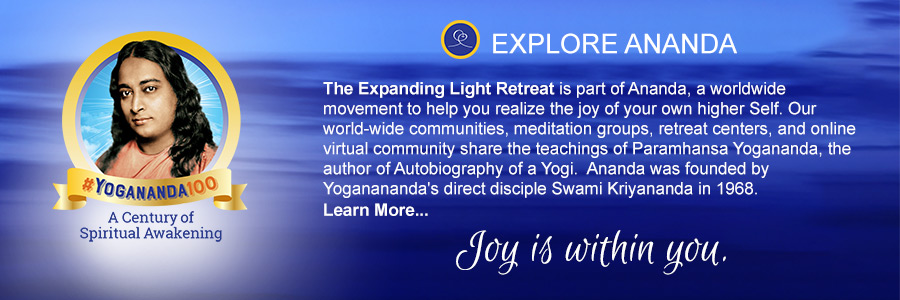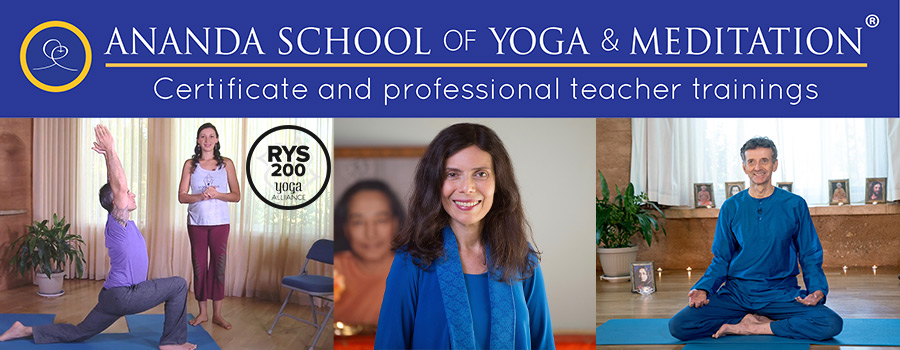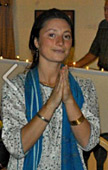New Answers for Ananda Meditation Teachers
By Nawaswami Gyandev
Finally: Meditation is mainstream and in great demand, due to the many benefits that research has proved in recent years, as well as to widespread spiritual seeking. It's even being prescribed by physicians. That's great news for meditation teachers.
With increasing public awareness of meditation, teachers are now more likely to be asked questions that previously didn't arise. Following are some of them, along with thoughts on how you might respond.
Simple Question, Simple Answer
You could be asked, “What kind of meditation do you teach?” Don't answer, “Hong-Sau,” because that won't make sense to someone who hasn't learned the technique. And don't say, “Ananda Meditation,” but that name alone gives no real information–and besides, as every marketer knows, people care more about benefits than about names. What most people really want to know is, “What benefits will I receive?” So you can start with a simple, benefit-oriented answer, such as:
I teach Ananda Meditation, a classical technique that improves concentration, reduces stress, calms the mind, and helps you connect with the highest parts of yourself.
I like to say “classical” because that implies legitimacy: The Hong-Sau technique is millennia old, as opposed to the here-today-gone-tomorrow practices one often sees these days. If the questioner is familiar with Paramhansa Yogananda, mention that you teach one of the main techniques that Yogananda taught.
If you suspect that the person might balk at spiritual benefits or the Sanskrit word “Ananda”–for example, she's with corporate Human Resources, interviewing you as a possible provider of meditation training–you could answer even more succinctly:
I teach a classical technique that improves concentration, reduces stress, and calms the mind.
If the person wants to know something about the practice of the technique–for example, she already knows a bit about meditation, and is curious about your technique–you could say:
I teach Ananda Meditation, a classical technique of concentration on the breath, aided by silent repetition of a special mantra that helps to focus and quiet the mind.
Mindful Questions
With all the recent publicity about mindfulness, someone might ask, “Do you teach mindfulness?” Ananda Meditation is different from mindfulness meditation, so you might be inclined to say “no.”
But wait: “Mindfulness” is now generic, having acquired such diverse meanings as:
- Mindfulness-based stress reduction, a contemporary meditative technique
- Some variants of that technique
- Re-packaging an unrelated kind of meditation, intended either to benefit from the publicity about mindfulness, or to avoid any spiritual connotations
- Meditation in general, apart from any specific technique
- Paying attention to whatever one is doing during outward activities.
So you need to find out what she really means before you can answer clearly.
Speaking of the impact of mindfulness publicity, one Ananda MTT grad recently asked whether potential corporate clients might prefer it to Ananda Meditation. I asked David Gamow of Clarity Seminars, who has taught Ananda Meditation to hundreds of corporations and organizations. David replied that he almost never gets asked what kind of meditation he teaches:
“From a corporate perspective, there's not much difference between Hong-Sau and Mindfulness, because although Hong-Sau could benefit a person much more (in my opinion), many of those greater benefits won't appeal to corporate clients. The corporate mindset is that the differentiating factor is the teacher, not the technique. They will choose a good Hong-Sau teacher over a poor Mindfulness teacher, and a good Mindfulness teacher over a poor Hong-Sau teacher.”
So it comes down to you, the teacher: your clarity, professionalism, magnetism, and experience.
By the way, David also shared that he has found it best to avoid Sanskrit in a corporate environment. He teaches Hong-Sau, but he calls it simply “meditation,” and he uses “I am peace” as the mantra.
Measuring Meditation
Someone might ask you about research into meditators' brain activity during (or after) meditation: which parts of the brain are active, and what types of brain waves are being generated. Such research can be interesting, as it helps one see correlations between subjective meditation experience and objective brain activity. (I'm not aware of such research for Hong-Sau.) It also provides a way to compare techniques.
But meditation is far more than numbers and physiology. To give such measurements too much importance is like saying, “The mind is what the brain does,” whereas any serious meditator eventually experiences the mind as being far beyond the brain or body. The statement “The mind is what the brain does” is simply bad science, because it's based on a bias toward physicality, not on proof.
So if you see such research results, remember that most physical scientists adhere to a purely physical model: They maintain that the brain is the cause of all mental activity, and that “mind” is nothing more than the aggregate of all brain activity. Conversely, most spiritual scientists assert that the brain is merely an instrument of the mind, which is not limited in any way by the body. In time, physical science will no doubt expand its views on this subject–as it has been doing in other subjects for centuries–but for now the two fields have divergent perspectives.
Classifying Meditation Techniques
In a rare instance, someone might ask you where Hong-Sau fits in psychology researchers' “typology,” an emerging classification system for meditation techniques. Although there is not yet general agreement on the classifications, and few people other than psychologists think in these terms, nevertheless it's good for a meditation teacher to be aware of this trend in psychology.
What types of meditation have been proposed so far? Here are the two main ones:
- Focused attention: the voluntary focusing of attention on a chosen object (e.g., a candle flame, an idea, or the breath)
- Open monitoring: non-reactive monitoring of the content of experience from moment to moment
A third, more-recently proposed type is:
- Automatic self-transcending (AST): techniques that transcend their own activity (that is, the practice “takes you to a different place” without your conscious attempt to go there); these techniques supposedly involve neither focus nor individual control/effort.
Psychologists might eventually end up with more–or fewer, or different-types as they seek to make statements about techniques according to what one does in the practice. But just as for the measurement approach, it's problematic to force meditation practices into a few little boxes.
One problem is oversimplification: For example, research on focused-attention techniques has shown that results can vary substantially according to the chosen object of attention. That calls for a much more complicated typology.
Another problem is the statement that AST techniques entail no focus or individual effort. Really? Without effort, you're not meditating at all. Relaxing, maybe, but not meditating. Effort might be subtle–concentrating, observing, repeating, merging, or “being there”–but it's vital, and deeper meditation requires greater effort.
A third problem is that the boxes are not mutually exclusive. Hong-Sau, for example, entails concentration on the breath (focused attention), yet when practiced deeply, it transcends its own activity, taking one into an effortless flow (AST). Another example: Some mindfulness techniques involve both concentration on the breath and monitoring of moment-to-moment experience (open monitoring). In both cases, the techniques have elements of two boxes, yet fit into neither box.
And Kriya Yoga? That would require a very different kind of box.
If your questioner really wants you to place Hong-Sau within this evolving typology, you could say that Hong-Sau has elements of both focused attention and automatic self-transcendence: It starts out as a focused attention technique, and at deeper levels of practice it becomes an AST technique.
Final Thoughts
Remember that, most of the time, a simple answer will convey all that your questioner really wants to know about what you teach. Simplicity also will avoid the shortcomings of measurements and typologies–and avoid giving more information than the questioner wants.
As any meditator knows, personal experience is the best and most accurate way to assess meditation techniques. Words can never tell that story; only the practice itself can do so.
Meditation Teacher Support Center
Articles
- About Meditation
- Inspiration for Your Teaching
- New Answers for Ananda Meditation Teachers
- Our Contribution to World Peace
- Short Stories
- All Articles
Advice


CONNECT
14618 Tyler Foote Rd
Nevada City, California 95959
Toll free 800-346-5350
Outside US 530-478-7518
LEARN MORE
SUBSCRIBE
Receive uplifting emails with inspirational content and news about our retreat programs, travels, and trainings.
















